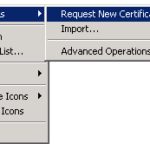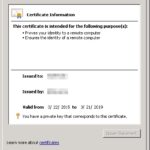Mit vSphere 6 bietet vMware eine eigene Zertifikatsstelle (vmcad) für seine Produkte an. Wer aber dennoch lieber eigene Zertifikate verwenden möchte kann dies natürlich auch weiterhin tun.
Zertifikat Request erstellen:
C:\Program Files\VMware\vCenter Server\vmcad>certificate-manager _ _ _ _ _ _ _ _ _ _ _ _ _ _ _ _ _ _ _ _ _ _ _ _ _ _ _ _ _ _ _ _ _ _ _ | | | *** Welcome to the vSphere 6.0 Certificate Manager *** | | | | -- Select Operation -- | | | | 1. Replace Machine SSL certificate with Custom Certificate | | | | 2. Replace VMCA Root certificate with Custom Signing | | Certificate and replace all Certificates | | | | 3. Replace Machine SSL certificate with VMCA Certificate | | | | 4. Regenerate a new VMCA Root Certificate and | | replace all certificates | | | | 5. Replace Solution user certificates with | | Custom Certificate | | | | 6. Replace Solution user certificates with VMCA certificates | | | | 7. Revert last performed operation by re-publishing old | | certificates | | | | 8. Reset all Certificates | |_ _ _ _ _ _ _ _ _ _ _ _ _ _ _ _ _ _ _ _ _ _ _ _ _ _ _ _ _ _ _ _ _ _ _| Note : Use Ctrl-Z and hit Enter to exit. Option[1 to 8]: 1 Please provide valid SSO password to perform certificate operations. Password: 1. Generate Certificate Signing Request(s) and Key(s) for Machine SSL certificate 2. Import custom certificate(s) and key(s) to replace existing Machine SSL certificate Option [1 or 2]: 1 Please provide a directory location to write the CSR(s) and PrivateKey(s) to: Output directory path: c:\tmp\6 2015-03-22T14:25:31.824Z Running command: ['C:\\Program Files\\VMware\\vCenter Server\\vmcad\\certool.exe', '--genkey', '--privkey', 'c:\\tmp\\6\\machine_ssl.key', '--pubkey', 'c:\\users\\admin\\appdata\\local\\temp\\2\\pubkey.pub'] 2015-03-22T14:25:32.064Z Done running command 2015-03-22T14:25:32.067Z Running command: ['C:\\Program Files\\VMware\\vCenter Server\\vmcad\\certool.exe', '--gencsrfromcert', '--privkey', 'c:\\tmp\\6\\machine_ssl.key', '--cert', 'c:\\users\\admin\\appdata\\local\\temp\\2\\vecs_crt.crt', '--csrfile', 'c:\\tmp\\6\\machine_ssl.csr'] 2015-03-22T14:25:32.116Z Done running command CSR generated at: c:\tmp\6\machine_ssl.csr
Anschließend diesen Request von seiner Zertifikatsstelle signieren und das Zertifikat im Base64 Format wieder auf dem Server zur Verfügung stellen.
Dann kann dieses jetzt importiert werden:
1. Continue to importing Custom certificate(s) and key(s) for Machine SSL certificate 2. Exit certificate-manager Option [1 or 2]: 1 Please provide valid custom certificate for Machine SSL. File : c:\tmp\6\machine_ssl.cer Please provide valid custom key for Machine SSL. File : c:\tmp\6\machine_ssl.key Please provide the signing certificate of the Machine SSL certificate File : c:\tmp\6\root-base64.cer You are going to replace Machine SSL cert using custom cert Continue operation : Option[Y/N] ? : y Status : 100% Completed [All tasks completed successfully]
Alternativ kann man auch mit Hilfe des Windos-Zertifikatsdienst ein Zertifikat anfordern, austellen lassen und exportieren:
Das Zertifikat als .pfx (mit Private Key’s) exportieren und anschließend per OpenSSL für vMware konvertieren.
Key exportieren:
openssl pkcs12 -in 123.pfx -nocerts -out key.pem -nodes Enter Import Password: MAC verified OK
Zertifikat exportieren:
openssl pkcs12 -in 123.pfx -nokeys -out cert.pem Enter Import Password: MAC verified OK
Passwort vom Key entfernen:
openssl rsa -in key.pem -out server.key writing RSA key
Die beiden Dateien (cert.pem & server.key) könnt ihr anschließend über den Certificate-Manager importieren.



